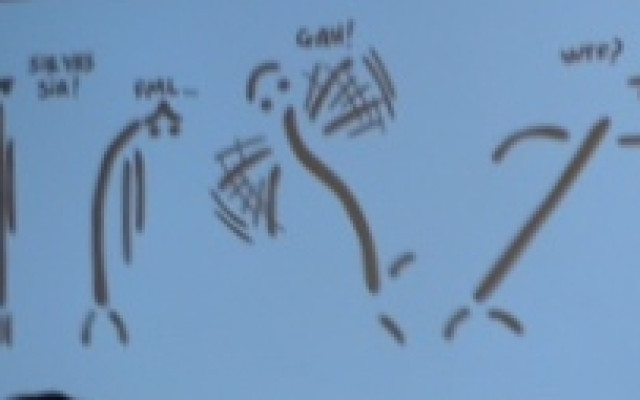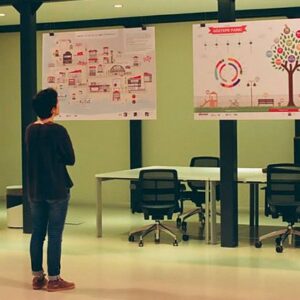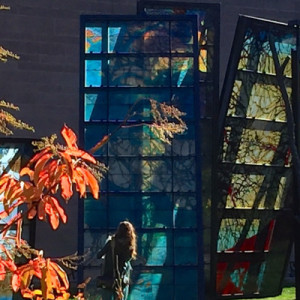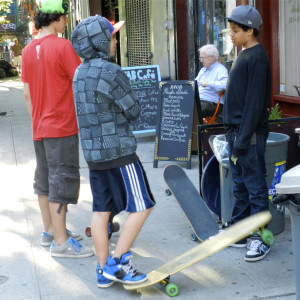STEM, Meet Design Thinking
From U.S. presidents to local principals, the message to improve student learning in STEM (Science, Technology, Engineering and Math) is loud and clear. But all too often the message fails to include any ideas of how to engage more students than just “the math and science kids” in STEM subjects. STEM, meet design thinking! Connecting STEM to design thinking may be a creative way to excite students about STEM and empower them to apply what they learn to solve problems and take on new challenges.
I really liked using my imagination. I haven’t used it for a long time. — California 7th grade design thinker
One school district marrying STEM and design thinking is the California Vista Unified School District, in particular a magnet middle school, the Vista Innovation and Design Academy. Knowledge Without Borders™ interviewed Eric Chagala, principal of the Academy, to find out how his school connects design thinking to STEM (as well as the creative arts and humanities).
Vista Academy administrators and teachers have become acquainted with design thinking through ongoing professional development and collaboration with the Stanford d. School and IDEO, as well as inter-faculty collaboration with the Nueva School in Hillsborough, California
The professional development process revealed several challenges among public school faculty in combining design thinking with a standards-based curriculum. “We noticed,” Chagala explains, “that content area teachers do not have the ability, while meeting standards, to always have students go through an entire design challenge.”

Chagala and his team added “Problem Finding” in front of “Empathize” in their approach to design thinking.
So the Academy added another “space” to the design thinking process — “Problem Finding” — in front of Empathize as an “into” for content area teachers. Teachers ask students to solve problems in content areas while acquainting them with the design thinking approach. Skills commonly integrated into design thinking such as empathy, observation, interviewing, and brainstorming are introduced within the context of standards-based topics. Once the students (and teachers) feel comfortable with design thinking, they can apply the process to cross-curricular design challenges or even school-wide design challenges.
While initial exploration of problems is guided by the teacher, the goal is to encourage students find and define problems. The Academy has even fashioned its own motto, “Problem Finders and Solution Designers,” to remind students of the leading role they play in their own learning when they use design thinking. This is a bold move in an era of aggressive statewide standardized assessments.
It would have been very difficult to implement design thinking in the “old days” to meet the “old” standards says Chagala. But not today. He believes the Common Core and design thinking are “meant for each other,” that students, if they are willing to take risks that come with an iterative approach, actually have the tools to excel in standardized testing without teachers teaching to the test.
We are betting that by allowing students to be risk-takers, to redefine failure, to collaborate, and deeply think will actually better prepare them for assessments than traditional models of learning. We want them to be thinkers. — Eric Chagala
Students and teachers address STEM competencies aligned with the Common Core and NGSS (Next Generation Science Standards) without relying on commercially-produced inquiry-based science kits. Rather, they apply design thinking as the “ultimate Inquiry Based pedagogy.”
Chagala believes that each component of STEM can be used to solve a design challenge: “science helps us find problems. technology and engineering provide use with the technical wherewithal to solve problems, and math often plays a supporting role.” He shared a story about his school’s 7th grade science students. Instead of the traditional approach of the teacher-dictated instructions on how to build a miniature bridge, the students read a story about a child who could not get across a river and discussed how different types of bridges might solve the problem.
Then the students apply design thinking — empathize, define, ideate, prototype and test — to design and build their own bridges. They ask questions and research the types of bridges that would best meet the user’s (child’s) needs, brainstorm lists of ideas, and build prototypes. Students and student teams prepare presentations, sharing how they used design thinking to build their final bridge. After each presentation, the students themselves conduct stress tests on their bridges, such as weight and capacity measurements, to determine if the bridge meets the needs of the users.
The Vista Innovation and Design Academy uses design thinking to engage middle schoolers to find creative and innovative solutions to STEM problems that affect everyone from individual students, classrooms and schools to the global community. We will follow the design thinking challenges tackled by Academy students and teachers throughout the school year.














I just read this article and found it informative. I hope I can see more in the future.